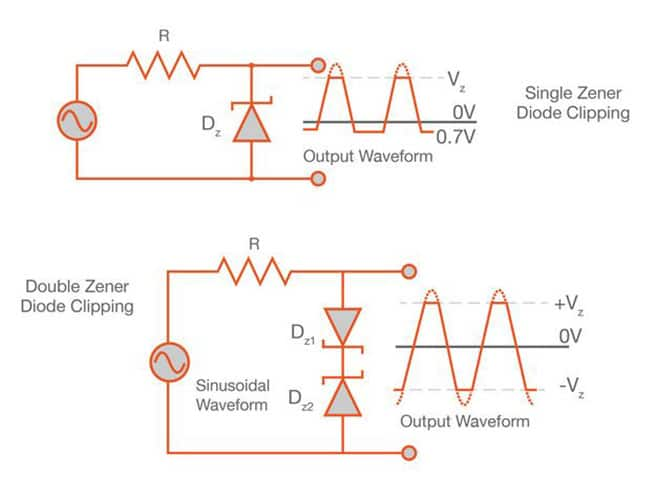Musings On Speed Control via Arduino
Musings On Speed Control via Arduino
|
Administrator
|
As some of you know, I'm having fits with the speed control on Big Blue. I'm almost to the point that I have nothing else to try. So I'm thinking about using an Arduino microprocessor to replace the speed control module (amplifier). And this thread is to document some of my thinking.
The Arduino would plug in exactly where the current speed control plugs in and be a plug & play replacement. That would allow going back, if needed. But, there would also be another connector that would bring in other functions, like allowing the Arduino to run the fuel gauge by monitoring the fuel tank switch and then using the right mapping table for the tank in use. I have a Word document that I'm working on in the background and I've thought about embedding it here, but let me try to summarize. First, these are the inputs to the speed control: PowerGroundHorn Pad OutputVehicle Speed Sensor + & -Servo PositionBOO: Brake on/offAnd here are the outputs: Servo Potentiometer Power & GroundServo PowerVent ValveVacuum ValveAnd the way I see it working is that there will be two interrupts: VSS: Each pulse of the VSS will cause an interrupt, and the routine will determine the time from the last interrupt, which gives speed, and the delta in time from previous interrupts which gives acceleration/deceleration. And those parameters will be saved.Switches: Pushing on any of the horn pad switches will cause an interrupt, and the routine will then figure out which switch was pushed and then cause the right flag to be set and the proper parameters to be saved. For instance, if Set is pushed the routine will grab the current speed and make it the set point for the controller.And the background routine will monitor the flags and cause the right things to happen. For instance, if the "ON" flag is set the controller routine will be called, but not if the flag is not set. Speaking of the controller routine, that will be a PID routine from the Arduino library. You can read up on proportional/integral/derivative controllers, but they are very standard in control systems and are a perfect fit for a speed control. But having fully tested PID code for an Arduino available makes this project much easier. In reality the hardest part will be tuning the three parameters (Kp, Ki, & Kd) which tune the PID controller. And speaking of that, the Arduino will have a USB connector which will allow me to tune those parameters on the fly via this tablet. (And it will let me tailor the fuel level tables on the fly as well, but that's another subject.) Anyway, that's probably enough for now. If someone is interested in the flow charts I have to this point I can share the Word document, but it is both rough and ever-changing.
Gary, AKA "Gary fellow": Profile
Dad's: '81 F150 Ranger XLT 4x4: Down for restomod: Full-roller "stroked 351M" w/Trick Flow heads & intake, EEC-V SEFI/E4OD/3.50 gears w/Kevlar clutches
|
|
Administrator
|
Subscribed and very interested

Scott
'Camano' 1986 F250 Supercab XLT Lariat 460/C6 'Chanute' 1980 F350 C&C 400/NP 435 - Gin Pole But there ain't nothin' wrong with the radio |
Re: Musings On Speed Control via Arduino
|
Administrator
|
In reply to this post by Gary Lewis
Gary, just for the heck of it, you have one of the latest versions of the speed control module (the red one) it is from a 1994 Taurus and I think 1995 was probably the last year to use it. Why don't you try that one once you get the speedometer and cable issue resolved.
Bill AKA "LOBO" Profile
"Getting old is inevitable, growing up is optional" Darth Vader 1986 F350 460 converted to MAF/SEFI, E4OD 12X3 1/2 rear brakes, traction loc 3:55 gear, 160 amp 3G alternator Wife's 2011 Flex Limited Daily Driver 2009 Flex Limited with factory tow package Project car 1986 Chrysler LeBaron convertible 2.2L Turbo II, modified A413 |
Re: Musings On Speed Control via Arduino
|
Administrator
|
I'll do that, Bill. In fact, as I walked by it this afternoon I thought "That thing is red - is it really that different?" So, I do plan to try it. Perhaps it has some better logic in it?
On the one hand, I'd love to do an Arduino to create a speed control that beats what the Bullnose speed controls do, hands down. But, I would be thrilled if the changes I've made suddenly "click" and things start working nicely. I have plenty of other things to do. Having said that, a PID controller wouldn't be all that hard to do..... 
Gary, AKA "Gary fellow": Profile
Dad's: '81 F150 Ranger XLT 4x4: Down for restomod: Full-roller "stroked 351M" w/Trick Flow heads & intake, EEC-V SEFI/E4OD/3.50 gears w/Kevlar clutches
|
|
Took my truck for a drive today and observed the cruise control.
I see where you’re coming from, even with the C6 to soften it up, it’s aggressive. I guess I’ve always sped back up close then engage it. I do that with the Xterra too. But using the buttons to slow down or speed up is annoying!
Dane
1986 F250HD SC XLT Lariat 4x4 460 C6-Sold 1992 Bronco XLT 4x4 351W E4OD 1998 GMC Sierra SLE K1500 350 4L60E Arizona |
Re: Musings On Speed Control via Arduino
|
Administrator
|
Dane - I've driven Blue several times in the last few days and find that Ford's speed control systems have come a long, long way since the Bullnose era. The ability to push a button once and get a speed up/down of 1 MPH, and gently I should add, is wonderful. And hitting resume when you are several MPH below doesn't get you WOT, or as close as it can, which my Bullnose units have done. Plus, as you crest a hill it doesn't over react and cut the throttle too much and then come back in with more throttle than needed.
I can see how the PID routine can make it so much better. Here's a slightly modified version of what Wikipedia says about the P, I, and D portions of the controller: Term P is proportional to the current value of the Set Point − Current Speed error. For example, if the error is large and positive, the control output will be proportionately large and positive, taking into account the gain factor "K". Using proportional control alone will result in an error between the setpoint and the actual speed because it requires an error to generate the proportional response. If there is no error, there is no corrective response.I accounts for past values of the Set Point − Current Speed error and integrates them over time to produce the I term. For example, if there is a residual SP − CS error after the application of proportional control, the integral term seeks to eliminate the residual error by adding a control effect due to the historic cumulative value of the error. When the error is eliminated, the integral term will cease to grow. This will result in the proportional effect diminishing as the error decreases, but this is compensated for by the growing integral effect.D is a best estimate of the future trend of the Set Point − Current Speed error, based on its current rate of change. It is sometimes called "anticipatory control", as it is effectively seeking to reduce the effect of the SP − CS error by exerting a control influence generated by the rate of error change. The more rapid the change, the greater the controlling or damping effect.In the setup of the controller you specify values for three parameters: Kp for the proportional calc's; Ki for the integral; and Kd for the derivative. But these parameters can be adjusted on the fly - in the case of an Arduino that can be done via a USB or Bluetooth connection from a computer or phone. To put it another way, Kp determines its initial reaction to hitting Resume when you are 20 MPH below the set point. Ki determines what happens during the run-up to the set point - does it continue to add more throttle because you are still below the set point? And Kd says "wait a minute, we are approaching the set point so let's back off just a bit so we don't overshoot." But while this would be a really fun project, I do have a few other things I want to do, so I'd be thrilled if I found that the latest changes to Big Blue make his speed control work acceptably. Or if Bill's red module does. So I'm not running off to buy the Arduino. But, I am thinking through how to do it. And a couple of those thoughts are: Connections: How to cleanly connect to the existing harness is a concern as I don't want to chop the connectors off and solder in. One thought is to use a speed control module's board but strip off the components and solder to the traces. Another is to use a purpose-made cable, like those from the speed control testers.Placement: It would be ideal if the Arduino could go where the current speed control module goes, but I think it'll be too big for that. So I'm thinking that placing it where the center speaker would go, under the dash pad, would work and run a USB cable down to the ash tray area for connecting to it.
Gary, AKA "Gary fellow": Profile
Dad's: '81 F150 Ranger XLT 4x4: Down for restomod: Full-roller "stroked 351M" w/Trick Flow heads & intake, EEC-V SEFI/E4OD/3.50 gears w/Kevlar clutches
|
Re: Musings On Speed Control via Arduino
|
Administrator
|
Gary, one of the things to understand, the newer speed control is now part of the PCM (Powertrain Control Module) so it now has the capability to, in addition to opening the throttle, upshift or downshift the transmission as needed. This allows the system to be aggressive if you are well under the set speed and when coasting downhill, downshift the transmission to control speed.
The first one of these I experienced was in our 2003 Chrysler Town and Country minivan. If I had it on cruise and entered one of the tunnels on the CBBT with no yankee tourons in the way, it would drop from 4th to 3rd if the speed went much over the set point. With a manual transmission you won't get that. The two Flexes are the same way, but, if I have speed set at say 58 mph, have to slow way down or stop for a light, and hit resume early, say 35 - 40 mph, it will still accelerate aggressively, possible downshifting and a lot of throttle. Since the engines are the Duratech 3.5L, they like Blue, will wind up like one on the old Hi Po 289s (upshift at roughly 6K). Trivia item, the Flex transaxle is a 6F50 and is also used by GM as a 6T50.
Bill AKA "LOBO" Profile
"Getting old is inevitable, growing up is optional" Darth Vader 1986 F350 460 converted to MAF/SEFI, E4OD 12X3 1/2 rear brakes, traction loc 3:55 gear, 160 amp 3G alternator Wife's 2011 Flex Limited Daily Driver 2009 Flex Limited with factory tow package Project car 1986 Chrysler LeBaron convertible 2.2L Turbo II, modified A413 |
Re: Musings On Speed Control via Arduino
|
Administrator
|
Yes, the speed control is part of the PCM, and the PCM certainly has the ability to shift gears on an automatic tranny. Blue does that, Janey's GLK does, etc.
But there's also been a huge change, progression really, in the "smarts" of the speed control. The Bullnose units appear to do the "proportional" bit of a PID controller, only. There's no integral nor derivative, or at least if there are those components then they are poorly implemented. But Blue's control is smooth. Somehow in the last 30 years between those two systems things progressed nicely.
Gary, AKA "Gary fellow": Profile
Dad's: '81 F150 Ranger XLT 4x4: Down for restomod: Full-roller "stroked 351M" w/Trick Flow heads & intake, EEC-V SEFI/E4OD/3.50 gears w/Kevlar clutches
|
Re: Musings On Speed Control via Arduino
|
Administrator
|
When you consider (a) how far computers have come since the 80s (Apple II, RadioShack TRS 80 etc.) and how far the computers in cars have come, Ford EEC-III, EEC-IV, EEC-V and beyond, Chrysler LM-PM, SMEC, SBEC, SBEC-II and beyond and (b) how small that little black or red box is in relation to the newer PCMs and finally (c) are the valves PWM or simply open and close? The reason for the last is the early EFI EGR controls were a two valve, vacuum and vent and under certain conditions would "chatter" trying to find the optimum position, later systems use a PWM control.
Bill AKA "LOBO" Profile
"Getting old is inevitable, growing up is optional" Darth Vader 1986 F350 460 converted to MAF/SEFI, E4OD 12X3 1/2 rear brakes, traction loc 3:55 gear, 160 amp 3G alternator Wife's 2011 Flex Limited Daily Driver 2009 Flex Limited with factory tow package Project car 1986 Chrysler LeBaron convertible 2.2L Turbo II, modified A413 |
Re: Musings On Speed Control via Arduino
|
Administrator
|
Yes, things have come a LONG ways since the 80's. And there's more to come - wait for a later post.
On the valves, the Vent valve is held closed to keep the vacuum in the servo and opened to release vacuum/slow down. The Vacuum valve is opened to add vacuum to the servo and, therefore, accelerate. As for PWM, I'll have to put the 'scope on the control lines to see what the signals look like. But I assume that they just are popped as needed. Now for the news. My nephew called to discuss GMRS radios as he is buying some. In the course of the conversation I told him about the possibility of building a speed control and he told me that he's discontinued using Arduinos. Instead he's using D1 Minis, which are "the size of a postage stamp" and have WIFI built in. He puts a power supply board (shield) under it and a MOSFET shield above it and away he goes. You can load the sketches over WIFI, change the parameters, watch what it is doing, etc. He has one set up to plug into a cigarette lighter and monitor voltage or other parameters, and it reports it to him via a Blynk server so he can pull its output up any time he wants on his phone. He has others set up to open his garage doors and he sends the commands via Siri and the Blynk server. So he thinks the speed control and fuel gauge applications are perfect for one of these. He is an ME so understands PID controllers better than I, but I explained my plans and he concurs. More later.....
Gary, AKA "Gary fellow": Profile
Dad's: '81 F150 Ranger XLT 4x4: Down for restomod: Full-roller "stroked 351M" w/Trick Flow heads & intake, EEC-V SEFI/E4OD/3.50 gears w/Kevlar clutches
|
Re: Musings On Speed Control via Arduino
|
Administrator
|
Ok, I promised more on the D1 Mini. First, here's a pic of the one he uses to open the garage door. He says "Siri, open the shop door" and Siri send a signal from his iPhone to the Blynk server to tell the Mini to open the door. That comes back down the internet, hits his wifi, and the Mini picks it up and closes the relay contact.
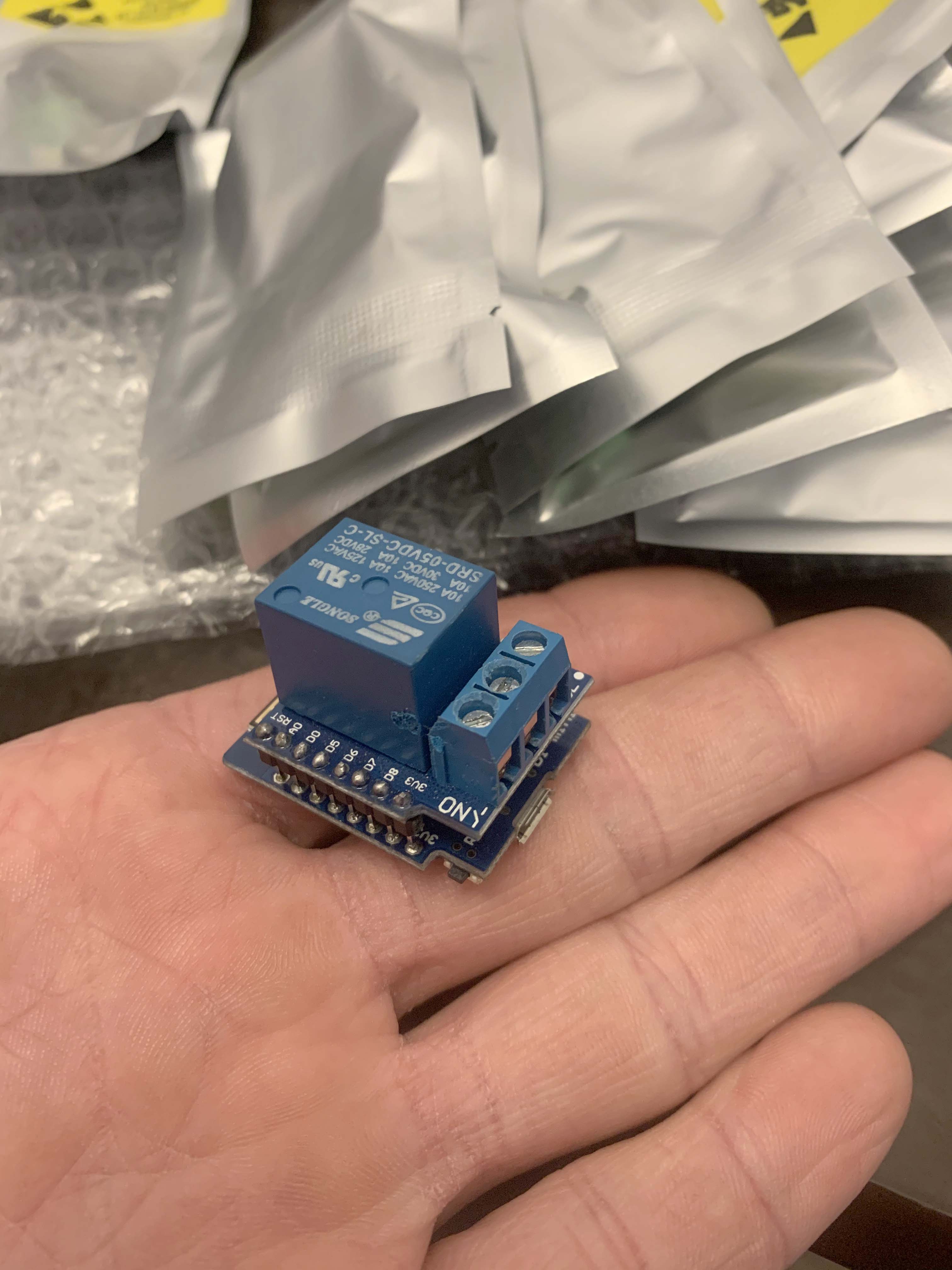 Yes, they are small - 1.01" wide and 1.35" long. And cheap - from $7 to $11 gets you one with 4 meg to 16 meg. Or, how about two of them plus two relay shields for $13? Or, maybe a 4-channel MOSFET shield for $6 that can drive up to 5 amps on each channel? Let's see, one for the Vent valve, one for the Vacuum valve, one for the fuel gauge, and one spare?  So, I'm thinking that one of these with a power shield (board) on the bottom and a MOSFET shield on the top will fit easily in the case of speed control amplifier. Take the old components off the speed control's board and use the board's edge connector for connection to the truck's harness. Plug and play. Add a connector to get the fuel tank switch's output, the senders, and the lead to the gauge and you can have a Meter Match equiv that has a table for each tank, and you can program it will driving. Fill the tank and cause the gauge to read Full. Calculate the usage at several mile points based on your normal MPG and when you hit that mile point make the gauge read where it probably should.
Gary, AKA "Gary fellow": Profile
Dad's: '81 F150 Ranger XLT 4x4: Down for restomod: Full-roller "stroked 351M" w/Trick Flow heads & intake, EEC-V SEFI/E4OD/3.50 gears w/Kevlar clutches
|
Re: Musings On Speed Control via Arduino
|
In reply to this post by Gary Lewis
This sort of thing should be up my alley, as I did a lot embedded Atmel AVR programming in college, to include on Arduino (which uses an AVR328C in the older versions), although I was using ANSI C, not "dummied down" Arduino language. I also took and aced a class on control systems in my senior year of college (for an EET degree). I've lost many details but know the concepts, so here goes
I'm pretty sure the cruise in my bullnose is using some sort of PID... it's just not tuned too well (or is hampered by external factors). Same experience where it falls on it's face at interstate speed (always want's to gear down) and overreacts on hills a lot (have to do a lot manual shifting in and out of OD if I dare use cruise). Although to be honest, that may be more a reflection on the performance (or lack therof) of my 300 and the stock 3.08 rear end. Some of the limitations I think have more to do with the usage of a vacuum servo for the throttle instead of the newer electric motor/spool setup (like my 1995 Ranger has). The motorized setup is more responsive and being run of the electrical system, is better regulated. The issue that vacuum systems can have is loss of vacuum under high throttle... the check valve and reservoir helps mitigate this, but it's still an inherently imprecise system in comparison. Having had the 84's vacuum module apart, you will have two solenoids (vacuum in, vacuum out) and a potentiometer (for plunger position). It's effectively two control systems at the same time; one for the speed control (PID), and another for regulating throttle position via vacuum (2-way control, since the solenoids aren't variable orifice). The PID's input is a sensor on speedo cable, either a hall effect tonewheel (like used for ABS, frequency modulated), or a rotating inductor type (which can either be used to generate a frequency or voltage, depending on the input circuitry), and it's output (throttle position or %) is the input of the 2-way control that modulates the vacuum servo to get the correct voltage out of the potentiometer. Killing the system when brakes applied is inferred by the controller seeing that the plunger position (potentiometer voltage) isn't responding to additional vacuum supply (due to the vacuum release on the brake pedal opening); I've had it drop out under excessive load which I think is this "feature" at work. Thus, there is no electronic BOO switch. I'm pretty sure the steering wheel buttons are single wire input with variable resistor values; this is used with an appropriatly sized pull up/pull down resistor and analog input (constantly poll the ADC). I've seen PWM tossed around... the bullnose system doesn't use it. PWM (in controls usage) is for variable control of DC devices (not the case here, since the solenoids are "digital"). It can also be used for communication (like Ford's implementation of OBDII on EECV), but with only one controller at play (without a means for external programming/debugging), there's no reason for it.
1984 F150: 300 L6, AOD, RWD. EEC IV / TFI, Feedback Carter YFA Carb. Stock everything but radio (for now).
|
Re: Musings On Speed Control via Arduino
|
Administrator
|
If the speed control is using PID then it has poor tuning. Sure would be nice to be able to change Kp, Ki, and Kd. (Which I will easily be able to do if I go with a microcontroller.)
I, too, had a control systems class, including PID's, but that was probably before you were born. So I don't remember a lot of it. But what I do remember says that it isn't difficult to dial a system in if you go about it systematically. This page has a couple of suggestions on how to approach that. But Crossco has a good explanation of what each parameter does as well as suggestions for how to start tuning. As for the vacuum servo being part of the problem, I don't think so. I had an all-vacuum Dana cruise control system back in the late 70's and it worked superbly. It came with different orifices for tuning things as well as some potentiometers, and I was able to dial it in just like I liked it on an Audi 100LS with a manual transmission. But speaking of manual transmissions, Big Blue will cruise up just about any hill around here in OD on speed control. And I've seen a steady 2" of vacuum on the gauge while doing it. So the system is quite capable of opening the throttle plenty far enough, and holding it there for an extended period. On the control buttons, you are right. It appears the speed control module has a pull-up and most of the control switches have a fixed resistor to ground. So when that button is pushed you get a specific voltage, which the microcontroller will read on an analog-in pin. But the On switch takes the input to battery voltage so I'll have to put a zener diode on that to limit it to the max the input can handle. And Off grounds the input. However there is a BOO input. In the diagram below you can see it in the upper left, with the brake switch in series to the clutch switch. I think the way it works is that the module has a pull-up resistor but the clutch switch keeps that input connected to the resistance of the brake lights, so with the clutch engaged the module sees 0V. But if the clutch clutch switch opens the pull-up takes the voltage to 12v and the system is disengaged. And if the brake switch is closed the input sees 12v and the system is disengaged. I'll probably put that on an interrupt and when it goes high reset the "On" flag. 
Gary, AKA "Gary fellow": Profile
Dad's: '81 F150 Ranger XLT 4x4: Down for restomod: Full-roller "stroked 351M" w/Trick Flow heads & intake, EEC-V SEFI/E4OD/3.50 gears w/Kevlar clutches
|
Re: Musings On Speed Control via Arduino
|
Administrator
|
And while I'm thinking of Zener diodes, I see the need to them used in three places:
BOO: As said, the brake input will go to battery voltage when the brake pedal is pushed, so I need to protect that input with a single-Zener arrangement and a current-limiting resistor, as shown below.Controls: Also mentioned is that pressing On will take that input to battery voltage so will also have to have a single Zener and limiting resistor.VSS: The input signal from the vehicle speed sensor is a sine wave and exceeds 20vp-p at 70 MPH, and is greater than 5v at 30 MPH. But instead of a single Zener I think I'll use a double-Zener arrangement as shown below. That will give me a good approximation of a square wave from the VSS and I should be able to get an interrupt to trigger off the leading edge, allowing me to easily determine speed as well as acceleration or deceleration.
Gary, AKA "Gary fellow": Profile
Dad's: '81 F150 Ranger XLT 4x4: Down for restomod: Full-roller "stroked 351M" w/Trick Flow heads & intake, EEC-V SEFI/E4OD/3.50 gears w/Kevlar clutches
|
Re: Musings On Speed Control via Arduino
|
Administrator
|
In thinking about stuffing a D1 Mini in the speed control's amplifier box I measured it and found that it is 3.925" wide x 2.660" long x 1.196" deep inside. The board sits .711" from the top of the box, so that's not a lot of space above the board for the D1 Mini. But I could cut the board right behind the snaps in the case that hold it in place and have 1 3/4" to the back of the case. However, I'd probably want to just cut out the center of the board, as shown, which gets the 2 1/4" x 1 3/4" space that would be 1" high when the bottom cover is on.
The D1 Mini by itself is only .28" high, but by the time the power supply shield is put on the bottom and the MOSFET shield is put on the top that may be a challenge.  
Gary, AKA "Gary fellow": Profile
Dad's: '81 F150 Ranger XLT 4x4: Down for restomod: Full-roller "stroked 351M" w/Trick Flow heads & intake, EEC-V SEFI/E4OD/3.50 gears w/Kevlar clutches
|
Re: Musings On Speed Control via Arduino
|
Administrator
|
In the previous post you can see an E7 version of the speed control module. Turns out I have at least three versions of the module: E3; E7; and the F1 that Bill gave me from the Taurus. And all use a chip with Ford #D9AF 14A607, but the E3 version has an A1B suffix while the other two have an A3B suffix, although the manufacturer's number is different between them.
Here they are in the above order. Note that the first two, E3 and E7, appear to have the same board layout. But the F1 has a completely different board. Maybe it has better function? 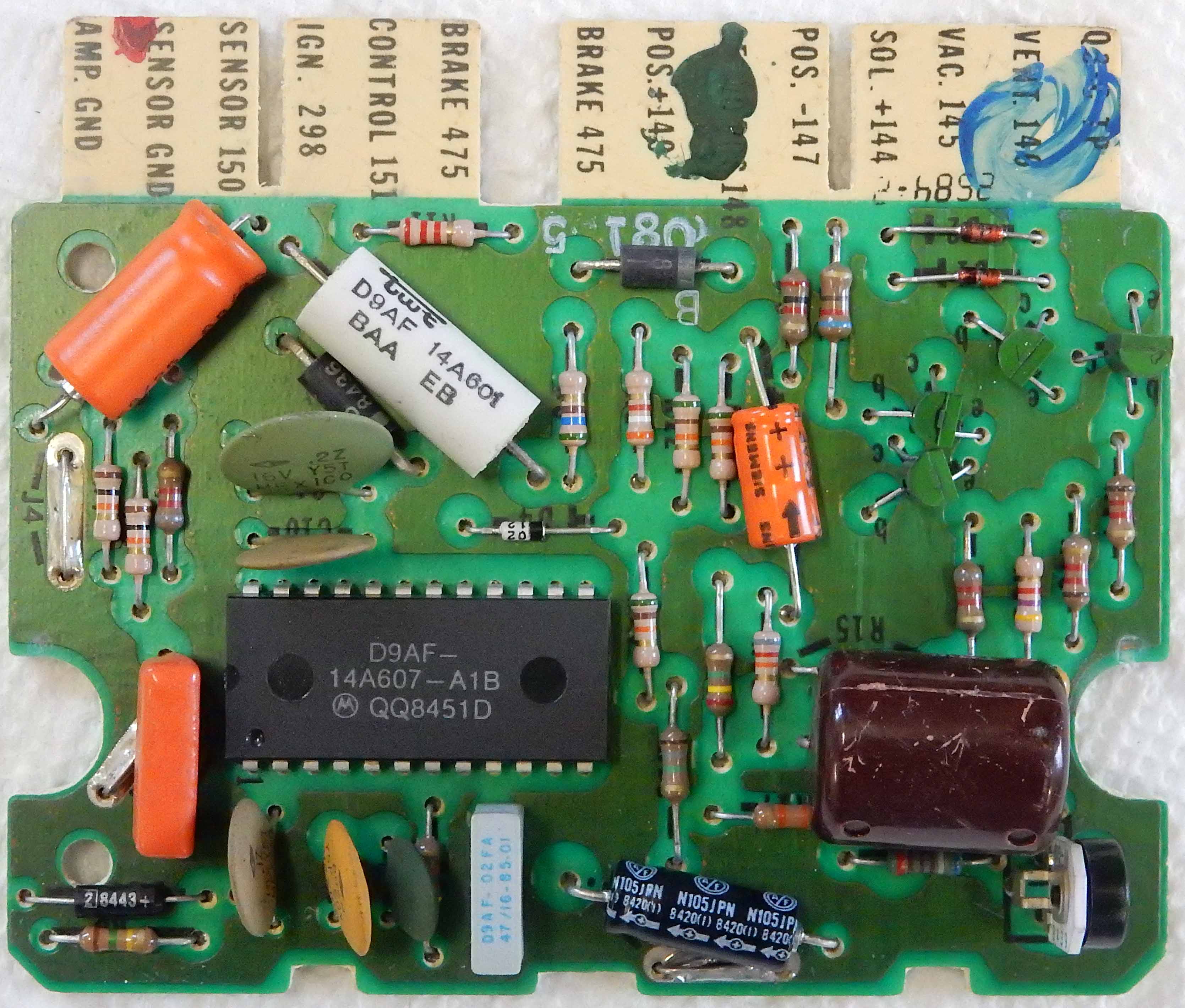 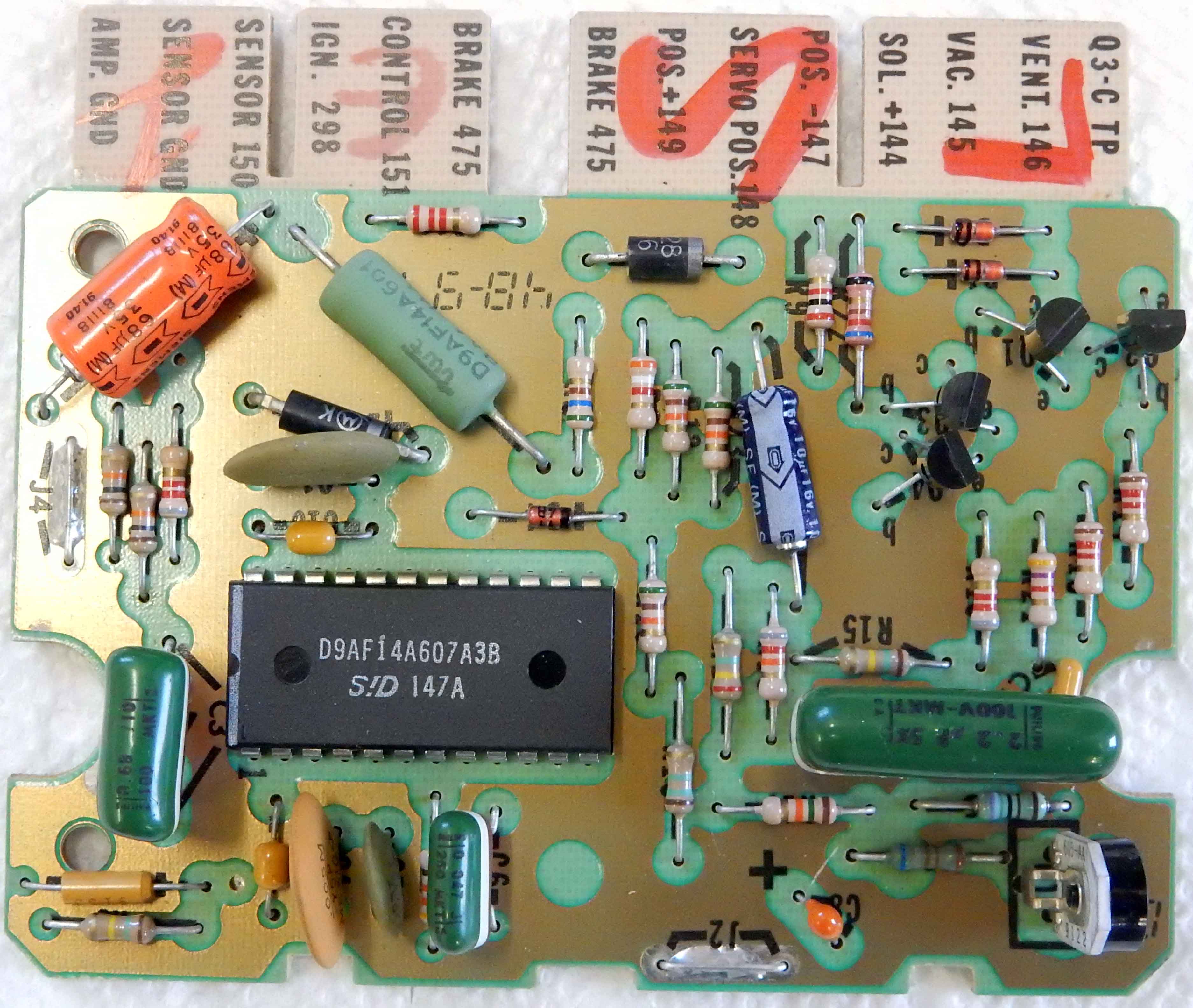 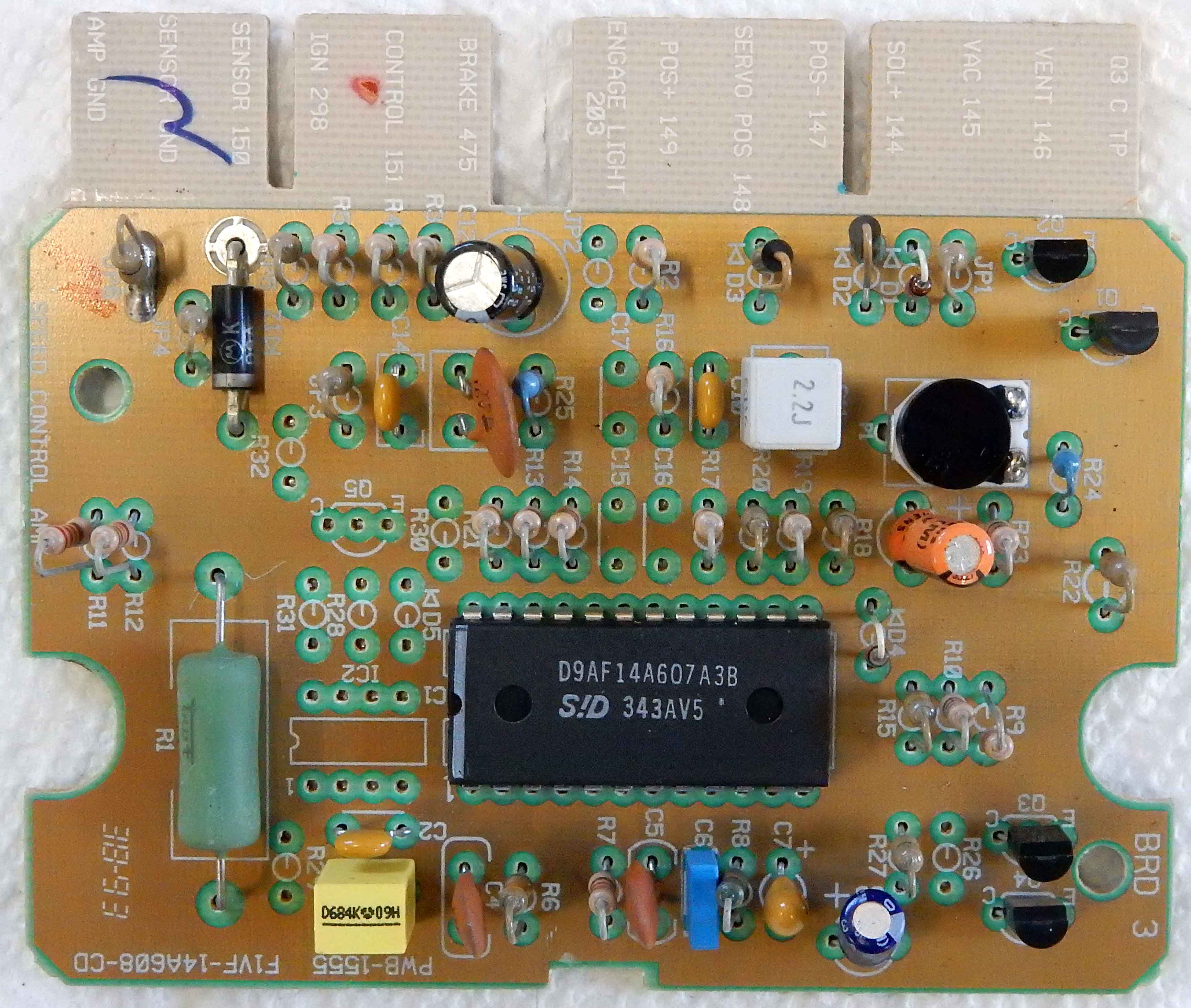
Gary, AKA "Gary fellow": Profile
Dad's: '81 F150 Ranger XLT 4x4: Down for restomod: Full-roller "stroked 351M" w/Trick Flow heads & intake, EEC-V SEFI/E4OD/3.50 gears w/Kevlar clutches
|
Re: Musings On Speed Control via Arduino
|
Administrator
|
Did some chatting with my nephew to get measurements on his "stack" of power supply shield, D1 Mini, and bits of the relay shield:
To top of terminal strip: .925"To top of relay: 1.220"That works out very nicely since there appears to be 1.038" between the bottom cover when snapped into place and the top of the box. And since I don't need the terminal strip will will use something like this 4-channel MOSFET shield. The top of the speed control board is .711" from the top of the box. Judging by the pic below the bottom of the relay shield is .500 from the bottom. And the MOSFET shield says it is .063" thick. So that would mean the whole stack would be .563" and it should fit on top of the speed control board if I just depopulate it. But what I'm not sure about is how to mount the stack on the speed control board.  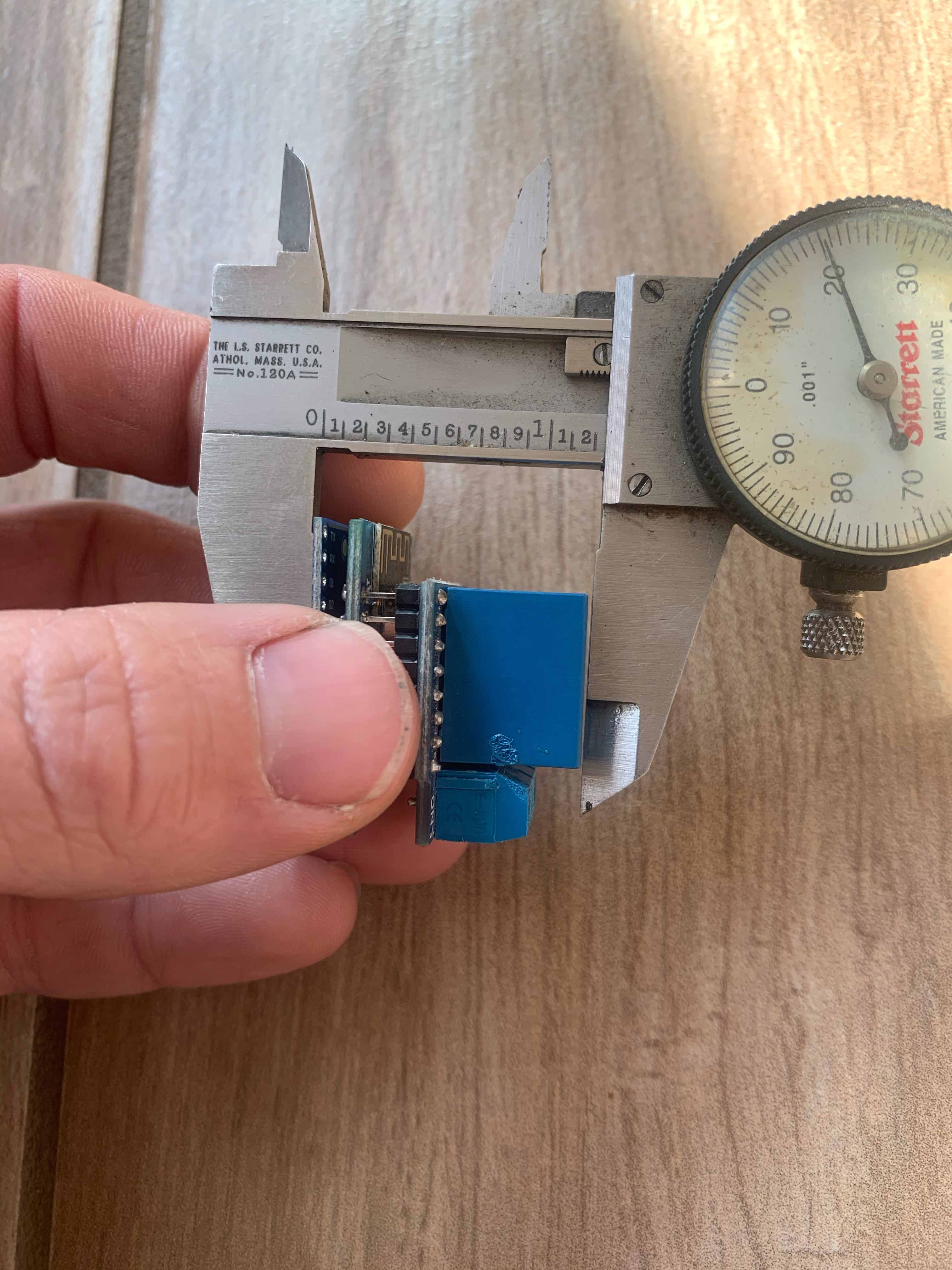
Gary, AKA "Gary fellow": Profile
Dad's: '81 F150 Ranger XLT 4x4: Down for restomod: Full-roller "stroked 351M" w/Trick Flow heads & intake, EEC-V SEFI/E4OD/3.50 gears w/Kevlar clutches
|
Re: Musings On Speed Control via Arduino
|
Administrator
|
In reply to this post by Gary Lewis
Gary, the difference on the chip is the source, the E3 is a Motorola chip, the other two are something different which would explain the suffix change.
You also have a different pin on one of the tabs on the F1 board, "engage light" which the Taurus did not have, but possibly a Lincoln model did (FiVF is a Lincoln part number prefix). 1991 Town Car with digital cluster has an engage or cruise on indicator.
Bill AKA "LOBO" Profile
"Getting old is inevitable, growing up is optional" Darth Vader 1986 F350 460 converted to MAF/SEFI, E4OD 12X3 1/2 rear brakes, traction loc 3:55 gear, 160 amp 3G alternator Wife's 2011 Flex Limited Daily Driver 2009 Flex Limited with factory tow package Project car 1986 Chrysler LeBaron convertible 2.2L Turbo II, modified A413 |
Re: Musings On Speed Control via Arduino
|
Administrator
|
Good catch on the engage light, Bill. But the other two have the brake signal on that pin, as well as the adjacent pin. So, can that module be used in the trucks?
 The "engage" light will be an output, and the brake will be an input. An output would be a "low" to sink current through a bulb to light it. And the brake input goes to battery voltage when the brakes are applied. So for a brief time when the brake signal goes high the output will still be low. But it would only be a really brief time, like a microsecond, so there would probably not be any damage done. I think it would probably work. Have you tried it?
Gary, AKA "Gary fellow": Profile
Dad's: '81 F150 Ranger XLT 4x4: Down for restomod: Full-roller "stroked 351M" w/Trick Flow heads & intake, EEC-V SEFI/E4OD/3.50 gears w/Kevlar clutches
|
Re: Musings On Speed Control via Arduino
|
Administrator
|
Look at the plug, it probably does not have a contact in that location.
Bill AKA "LOBO" Profile
"Getting old is inevitable, growing up is optional" Darth Vader 1986 F350 460 converted to MAF/SEFI, E4OD 12X3 1/2 rear brakes, traction loc 3:55 gear, 160 amp 3G alternator Wife's 2011 Flex Limited Daily Driver 2009 Flex Limited with factory tow package Project car 1986 Chrysler LeBaron convertible 2.2L Turbo II, modified A413 |
| Edit this page |


